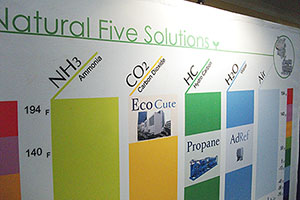EDITOR’S NOTE: Hank Bonar, owner of Bonar Engineering and Construction (www.bonareng.com) of Jacksonville, Florida, provided the following as part of his response to a story on refrigeration trends in the Sept. 8, 2014 issue of The NEWS. A portion of this was used in that story; here, Bonar’s comments are presented in their entirety.

|
| With ammonia and CO2 among the key players in the so-called ‘natural’ refrigeration sector, advocates are finding ways of combining the two in cascade refrigeration systems for commercial applications. This display was featured at a past Atmospheres America conference. |
For the last 50 to 60 years, most refrigerated perishable food storage and processing facilities have been using ammonia as the refrigerant of choice. This was even more the case as the effect of CFCs and HCFCs on the ozone layer became apparent. In addition to being biodegradable, ammonia is more efficient than CFCs and HCFCs.
As energy cost, life safety, product risk, and advances in thermodynamics became more defined and developed, a combination refrigeration cycle began to appear. This cycle uses a small amount of ammonia — located in the machinery room to provide the high temperature portion of the two stage system — and CO2 for the lower temperature stage of the system. Known as a cascade system, the system uses ammonia where it is more efficient and CO2 where it is more efficient. Both refrigerants are natural and green while operating as a closed system contained inside pipes and vessels. Some of the advantages include the following;
1) CO2 is green, a natural refrigerant
2) Improved efficiency
3) Lower installed first cost
4) Reduced risk, exposure to ammonia
5) Reduced product damage risk
6) Lower refrigerant cost
7) Lower maintenance cost
8) Minimizes fire, explosion risk
There are an estimated 30 to 40 cascade refrigeration systems in operation in the United States and many more under construction. Europe already has 300 to 400 facilities using cascade systems.
At the current rate of growth, we project by mid-century, 50 percent of the refrigerated storage and processing facilities will be cascade.


Report Abusive Comment